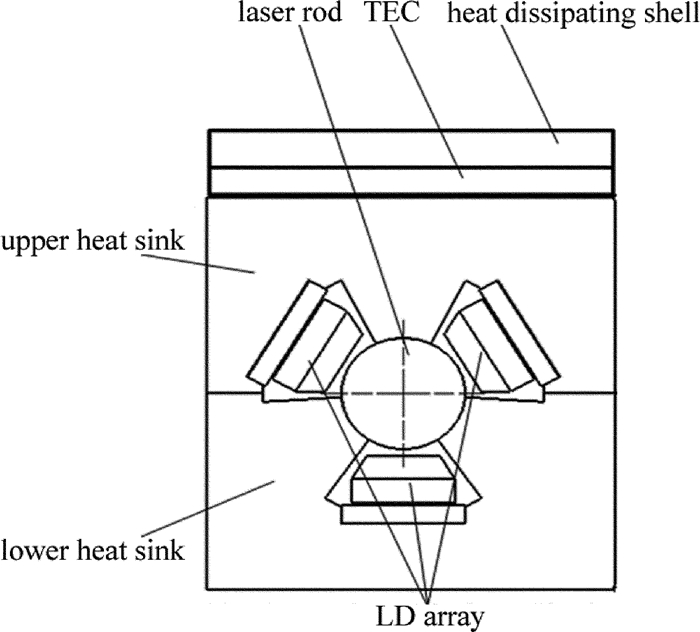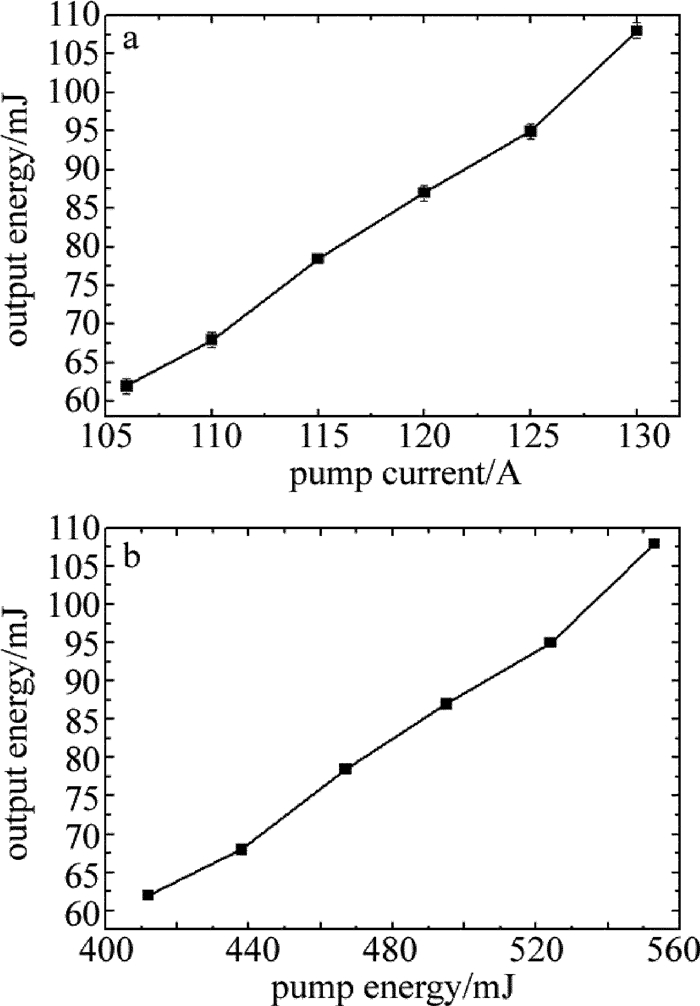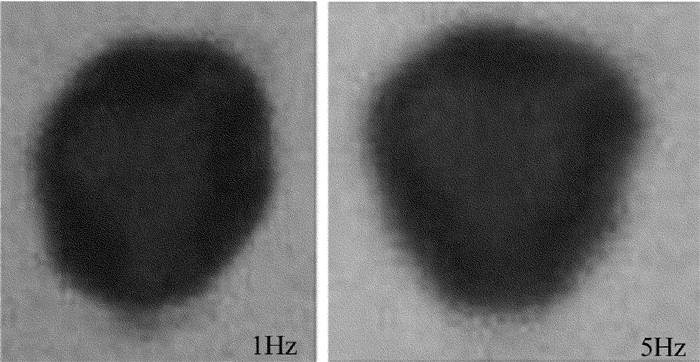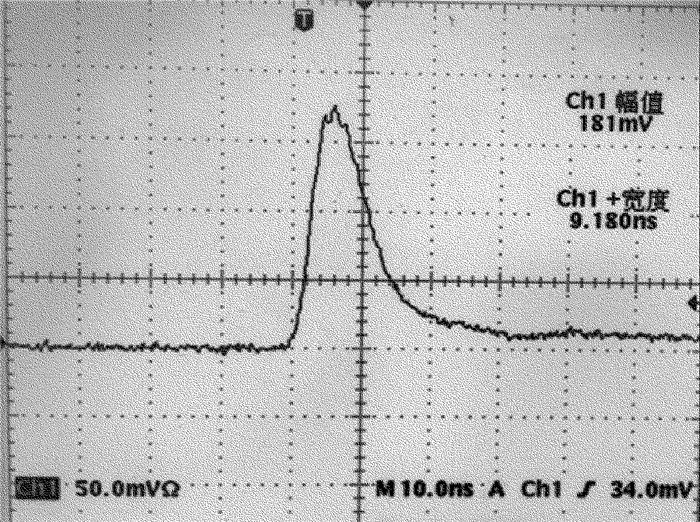Miniature high-energy symmetrically-pumped conductive cooling laser
-
摘要: 为了解决热传导散热激光器抽运和散热不均匀导致光束质量下降的问题,采用一种对称抽运和对称散热的激光抽运构型,结合激光棒端面直接镀膜技术,设计了一种小型化热传导激光器,并进行了试验验证。结果表明,激光器在5Hz重复频率下输出大于100mJ的能量,脉冲宽度为9.18ns,能量稳定度优于8%;且通过了高低温、振动试验,性能稳定。这种对称抽运热传导激光器具有结构简单、输出能量高和光束质量好的优点,特别适合用于小型化机载激光测距领域。Abstract: In order to solve the problem of beam quality decline induced by asymmetrical pumping and cooling of traditional conductive cooling lasers, one laser pumping structure with symmetrical pumping and cooling was adopted. Combined with direct coating film on laser rod end face, one miniature conductive cooling laser was designed and tested experimentally. The results show that, the output laser energy is more than 100mJ, with the laser pulse repetition of 5Hz. The laser pulse width is 9.18ns, and the energy instability is better than 8%. The laser works steadily under high and low temperature or vibration circumstance. The symmetrically-pumped conductive cooling laser has advantages of simple structure, high energy and good beam quality. It is very suitable for miniature airborne laser rangefinders.
-
Keywords:
- lasers /
- conductive cooling laser /
- symmetrically pump /
- miniature
-
引言
随着新一代战斗机的发展,机载光电探测系统的应用越来越普遍,而光电探测系统也正向着小型化、集成化方向发展[1]。因此,对机载激光器的要求也趋向于小型化、高能量和高光束质量方向发展。半导体激光器(laser diode,LD)阵列抽运的固体激光器相比脉冲氙灯抽运的固体激光器具有很多优点,如效率高、寿命长、能量损耗较低、热负载较少、质量较轻、体积较小等[2-5],因此在很多范围内得到了广泛应用[6-8]。热传导激光器是利用热沉对LD阵列和激光棒进行传导散热的激光器,相比于液冷激光器,省去了大水箱和各种管道,既减轻了重量又消除了漏液风险,因而非常适合于机载光电探测系统的应用。
热传导激光器需要对LD阵列和激光棒实现良好散热。2001年,CHEN等人将激光棒一部分侧面与热沉紧密结合,另一半侧面用来接收抽运光[9]。2016年,DONG等人[10]也采用的是这种方法。但在这种抽运构型中抽运和散热均不均匀,输出激光光束能量分布不均匀,从而导致光束质量较差,应用会受到限制。为了弥补抽运光的不均匀性,2007年, LU[11]和GUO[12]等人均采用两个半环形阵列交叉对称抽运。2009年CHEN[13]和2011年YANG等人[14]也分别采用了此种抽运构型。但在这种抽运构型中需要两个激光棒串接使用,增加了腔长同时也加大了损耗,而且由于散热仍然不对称,在抽运功率较高时,势必会导致激光棒应力变形,从而影响激光光束质量。2013年,BEZYAZYCHNAYA等人[15]在激光棒外侧加装一个蓝宝石套管,并在套管中填充低吸收散热粉末,用于对激光棒散热的同时,可以增强激光棒对抽运光吸收的均匀性。该构型工艺较为复杂,且LD阵列还需要额外的散热空间,体积较大,不适合机载应用。
本文中提出了一种对称抽运对称散热的激光器构型,具有体积小、重量轻、结构简单的优势,同时又具有较好的光束分布,特别适合用于机载小型化激光测距机。
1. 激光器构型
激光器构型如图 1所示。M1为平面反射镜,电光晶体采用磷酸二氘钾(potassiumdeuteriumphosphate,KD*P)晶体,P为偏振片,λ/4波片结合KD*P晶体和偏振片组成调Q开关。工作物质采用原子数分数为0.01的Nd:YAG激光棒,尺寸为∅5mm×40mm,侧面打毛,两个端面一端镀1064nm增透膜,另一端镀反射率R=20%的反射膜,作为直接输出端面。整个激光器腔长为140mm。
抽运腔构型如图 2所示。激光棒夹在上下热沉之间,在与上下热沉的接触面上铺上铟箔,以减小热阻,从而有利于传导散热。LD阵列模块分别固定在上下热沉上,沿激光棒方向共有2组,每组3个阵列模块,横向呈120°角对称分布于激光棒周围,采用近距离直接耦合抽运。阵列模块与热沉之间也铺有铟箔,以利于散热。上下两个热沉也通过铟膜紧密接触,实现传导散热。在上热沉和散热壳体之间装有半导体热电致冷器(thermo electric cooler,TEC),用于实现LD阵列的温控。每个阵列模块对称分布在激光棒周围,实现对激光棒的均匀抽运,对称抽运的构型有利于实现激光棒内增益的均匀化,从而有利于提高激光器的光束质量。
2. 模拟仿真
为了模拟三面对称抽运时激光棒的热传导情况,利用LASCAD软件对激光棒的受热及温度分布进行了模拟仿真。
模拟时,LD抽运平均功率为3W,激光棒边界温度与环境温度保持一致。激光棒的热负载分布仿真结果如图 3a所示。三面对称抽运的结果,使得热负载呈近似圆形,有利于补偿热透镜效应。激光棒的温度分布仿真结果如图 3b所示。由于三面对称抽运和三面对称热传导,使得温度分布在横截面内也近似呈圆形分布,有利于实现较好的光束质量。
3. 试验结果
常温下,使用半导体阵列驱动电源对阵列进行供电,抽运脉冲宽度为200μs。利用型号为OPHIR NOVA Ⅱ的能量计对输出激光脉冲能量进行测量。通过TEC将LD阵列温控在60℃,阵列抽运电流设在106A(此时对应抽运能量为412mJ),在重复频率为1Hz时,测得激光器输出能量为62mJ,连续工作1min时的能量稳定度为1.6%。在重复频率为5Hz时,测得激光器输出能量为63mJ,连续工作1min时的能量稳定度为4.7%。进一步提高抽运电流,试验测得激光器的输出能量随阵列抽运电流和阵列抽运能量的变化曲线如图 4所示。由图 4可以看出,激光器输出能量随阵列抽运电流呈线性增加。当抽运电流达到130A时,激光器最高输出能量为108mJ,此时最高抽运能量为553mJ,对应的激光器光光转换效率为19.5%,激光器的斜效率为32.3%。从激光器输出能量趋势看,激光器输出能量远远没有达到饱和状态。随着抽运电流的提高,激光输出能量还会继续增大。激光器常温工作过程中,利用TEC温控和散热壳体的传导散热,激光输出脉冲能量表现出较好的稳定性。
使用感光相纸记录不同重复频率下的光斑形状,如图 5所示。经测量,激光输出光斑大小为∅4.5mm。由图 5可知,光斑呈稍微变形的三角形分布,与模拟计算的结果较为吻合。稍微变形是由于聚光腔上下热沉在实际装配时,存在一定的装配偏差,从而导致抽运光和散热不能够完全的对称,因而光斑会存在变形。
利用套孔法测量了激光器的输出发散角。测试时,采用焦距为2.5m的长焦透镜对激光器输出光斑进行聚焦,在透镜焦平面上放置直径5mm的小孔,在小孔后放置能量计。横向移动小孔位置,使得透过小孔的能量最大记为E1,去掉小孔后,能量记为E0,则激光器的发散角,通过下式进行计算:
θ=df√−2ln(1−E1E0) (1) 式中, θ为发散角(mrad); d为小孔直径(mm); f为透镜焦距(m)。
经过测量,激光器直接输出激光发散角为1.2mrad,因此激光器输出的光束质量因子M2=4,表现出较好的光束质量。
使用型号为New Focus 1623的纳秒探测器结合Tektronix TDS 3034B型300MHz示波器,测量得到激光器输出的脉冲宽度为9.18ns,如图 6所示。
为了验证激光器在机载环境下的适应性,对激光器进行了低温-55℃和高温60℃条件下的环境试验,试验结果如下。
(1) 低温-55℃时,通过TEC对上下热沉进行加热,将LD阵列温控在60℃,从而实现低温条件下激光器稳定输出。经试验测试,在LD抽运电流为145A时,对应LD抽运能量为641mJ,此时激光器输出能量为102mJ,对应激光器电光效率为15.9%。激光器在低温下效率有所下降,经分析认为这是由于低温下通过TEC对热沉进行加热温控时,热沉与环境温度存在较大的温差,会导致激光棒存在一定的变形,从而降低了激光器的效率。
(2) 高温60℃时,通过TEC对上下热沉进行散热温控,将LD阵列温控在60℃。高温下,激光器连续工作1min,在LD抽运电流为127A时,对应LD抽运能量为535mJ,输出激光能量为104mJ,稳定度为6.6%,对应的光光转换效率为19.4%。由于采用的LD阵列为高温阵列,工作温度点与高温环境一致,因此高温条件下不需要额外的风扇散热,即可实现较好的温控效果,而且激光棒变形很小,因此激光器具有较高的光光转换效率。
对激光器也进行了振动试验,振动前后激光器输出能量没有变化。
整个激光器封装后尺寸很小,约为140mm(长)×23mm(宽)×30mm(高),在5Hz重复频率条件下,输出大于100mJ的激光能量,同时脉冲宽度较窄,发散角小,表现出较好的光束质量, 且经过高低温环境及振动试验验证,性能稳定,因此, 特别适合于小型化机载激光测距机领域。
4. 结论
针对热传导散热激光器抽运和散热不均匀的问题,本文中提出了一种对称抽运对称散热的激光构型,具有体积小、结构简单、输出能量高、光束质量好的优点。在5Hz重复频率条件下,获得大于100mJ的纳秒激光脉冲,脉冲宽度为9.18ns,且经过高低温振动试验,性能稳定,特别适合用于小型化机载激光测距机的发射光源。
-
-
[1] YANG Y, DING Q X, LIU H M. Application of laser technology in airborne EO detection and guidance system[J]. Infrared and Laser Engineering, 2008, 37(s3): 14-20(in Chinese). http://en.cnki.com.cn/Article_en/CJFDTOTAL-HWYJ2008S3004.htm
[2] TSO Y F, ROBERT L B. Diode laser-pumped solid-state lasers[J]. IEEE Journal of Quantum Elecronics, 1988, 24(6): 895-912. DOI: 10.1109/3.210
[3] WALTER K. Solid-state laser engineering[M]. 6th ed. New York, USA: Springer Science+Business Media, Inc., 2006: 300-303.
[4] LI L, DONG W W, NIE J P, et al. Transient thermal analysis of Nd:YAG crystal end-pumped by pulsed diode laser[J]. Laser Technology, 2011, 35(1): 94-98(in Chinese). http://en.cnki.com.cn/Article_en/CJFDTotal-JGJS201101028.htm
[5] LEI Ch Q, WANG Y F, HUANG F, et al. Progress of high power solid-state laser pumping and coupling technology[J]. Laser Technology, 2011, 35(6): 725-733(in Chinese). http://en.cnki.com.cn/Article_en/CJFDTOTAL-JGJS201106003.htm
[6] GUO Sh Y, HU X, YAN Zh A, et al. Research development of space-borne lidar in foreign countries[J]. Laser Technology, 2016, 40(5): 772-778(in Chinese). http://en.cnki.com.cn/Article_en/CJFDTotal-JGJS201605032.htm
[7] LUO Y, HE Y, GENG L M, et al. Long-distance laser ranging lidar based on photon counting technology[J]. Chinese Journal of Lasers, 2016, 43(5): 0514001(in Chinses). DOI: 10.3788/CJL
[8] CLIFTON W E, STEELE B, NELSON G, et al. Medium altitude airborne Geiger-mode mapping lidar system[J]. Proceedings of the SPIE, 2015, 9465: 946506. DOI: 10.1117/12.2193827
[9] CHEN X Y, ZHAO G. Study on thermal stability characteristic of miniature conductive cooling repetitive(5pps) (Nd, Ce):YAG laser[J]. Laser Technology, 2001, 25(1): 63-66(in Chinese). http://en.cnki.com.cn/Article_en/CJFDTOTAL-JGJS200101014.htm
[10] DONG J, LIU X Sh, SI H Y, et al. 350mJ LD side-pumped Q-swtiched Nd:YAG laser without water cooling[J]. Chinese Journal of Lasers, 2016, 43(11): 1101005(in Chinese). DOI: 10.3788/CJL
[11] LU Ch Y, LI L, LIU X, et al. Laser diode pumped passively Q-switched laser with corner-cube resonator[J]. Acta Optica Sinica, 2007, 27(7): 1228-1231(in Chinese). http://www.wanfangdata.com.cn/details/detail.do?_type=perio&id=gxxb200707015
[12] GUO Y X, GONG M L, XUE H Zh, et al. Semi-circum ferential LD arrays symmetrically pumped solid state lasers[J]. Laser Technology, 2007, 31(1): 85-88(in Chinese).
[13] CHEN X Y, JIN G Y, YU Y J, et al. Electro-optic Q-switched of double LDA alternate symmetric side pumped Nd:YAG laser[J]. Acta Optica Sinica, 2009, 29(11): 3098-3102(in Chinese). DOI: 10.3788/AOS
[14] YANG X T, MA X Zh, LIU Y. High-energy LD side-pumped Q-switched air cooling Nd:YAG laser[J]. Laser & Optoelectronics Progress, 2011, 48(11):111405(in Chinese). http://d.old.wanfangdata.com.cn/NSTLQK/NSTL_QKJJ0234179765/
[15] BEZYAZYCHNAYA T V, BOGDANOVICH M V, GRIGOREV A V, et al. Transversally diode-pumped Q-switched Nd:YAG laser with improved power and spatial characteristics[J]. Optics Communications, 2013, 308(11): 26-29. http://www.sciencedirect.com/science/article/pii/S0030401813005798
-
期刊类型引用(2)
1. 万玮华,郝培育,滕云鹏,李金全,李毅,郝海洋. 端面抽运的正交直角棱镜腔激光器研究. 激光技术. 2023(05): 600-605 .  本站查看
本站查看
2. 张培培,谢国坤,王昭. 激光超声波定向传输信道特性测试系统. 激光杂志. 2020(11): 162-166 .  百度学术
百度学术
其他类型引用(1)




 下载:
下载:




